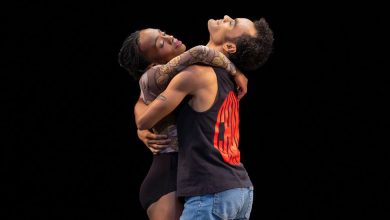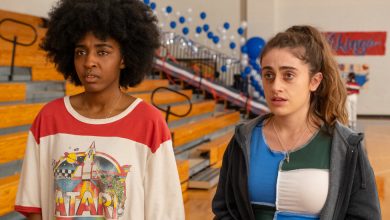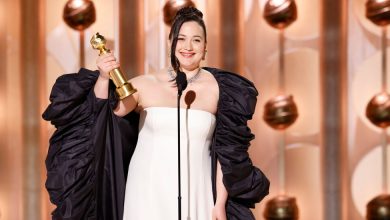Watching ‘Queer as Folk’ but Craving ‘Heartstopper’

I’ve been watching gay television since Steven Carrington was a ’mo on “Dynasty.” I cried when a gay son died of AIDS in “An Early Frost,” rejoiced when Jack slipped Ethan the tongue on “Dawson’s Creek” and melted as Patrick married David on that other “Creek” — Schitt’s.
Then there was “Queer as Folk.” I came of age as a gay man watching two versions: The 10-episode original that first aired in Britain in 1999 and the five-season American remake that premiered a year later on Showtime.
I’d never seen anything like it. Some of the actors were gay and others were not, and people debated whether that was good or bad. (They still do.) The American version was on a major cable outlet. Both versions had ensembles of gay characters who were in their late 20s like me. We were gay and urban and went on wonderful dates with terrible guys and had robust sex lives.
A new “Queer as Folk” made its debut earlier this month on Peacock, but it isn’t a reimagining, as it’s billed. It’s a restart. Set in New Orleans, the characters include people who are transgender, nonbinary and disabled, played by out, mostly unknown actors of many colors. Kim Cattrall and Juliette Lewis play moms. It even has a Pulse-style nightclub massacre in Episode 1, in case you need more trauma plots in your TV diet.
Reviews have been mixed. “A joyous attempt to probe queer stories for all they are worth,” said the AV Club. “Has trouble locating its humanity,” countered Vanity Fair.
I couldn’t get into it. Because the creators never fully figured out how to make their characters complex beyond outlines of identity. (A friend couldn’t decide if “Queer as Woke” or “Woke as Folk” would have been a better title.) The show’s made-for-TV friend group has the emotional depth of strangers at freshman orientation. The actors believe in their lines, but they don’t always act them believably.
In that sense, this new “Queer as Folk” joins the ranks of other major queer and queer-friendly revivals and reboots that in recent years have overextended themselves in service of the otherwise admirable goal of diversifying main casts that originally were mostly white and cisgender — people whose gender identity matches the sex they were assigned at birth.
Similar criticism has circled “The L Word: Generation Q,” a revival of the hit Showtime series “The L Word.” In a critique of Season 2, The Los Angeles Times wrote that “the optics of representation can only do so much when narratives are one-dimensional, fractured or guided by outdated tropes.” “And Just Like That,” the “Sex and the City” revival, made related mistakes in search of Queer Bushwick’s approval.
“The performance of diversity”: That’s how Julia Himberg, an associate professor of film and media studies at Arizona State University, described what happened with “And Just Like That” and “Generation Q.” (She had not seen the new “Queer as Folk.”) Himberg, a lesbian, is the author of “The New Gay for Pay: The Sexual Politics of American Television Production.”
“Representation matters,” she said. “But when it’s disconnected from a deeper story line or a deeper investment in the characters or the quality of the writing isn’t good, that has an impact on audiences’ ability to connect to the show.”
I agree. I believe we are at a place — please, let us be at a place — where it’s no longer enough that there’s a queer show with characters who look like you on it; diversity must be the baseline, not the finish line. And so, what began as a recent reporting assignment to New Orleans for a taping of the new “Queer as Folk” turned into a deeper inquiry, including conversations with friends, academics and others outside the production.
The good news is, if you are a queer person who finally sees yourself on television in the new reboot, it may not matter whether it’s good or bad — being seen means the world. If you don’t like the show, you have the luxury, decades in the making, of watching new and original queer series like the new hit Netflix show “Heartstopper,” an example of how diversity and good writing — thoughtful, complex, lived-in — can work together.
Pain vs. puppy love
“Heartstopper” offers an accessible and aspirational story — a combination that appears to be working. (Amid slowing revenue and layoffs, Netflix has already renewed it for two more seasons.) It turns out that what a lot of folks want right now isn’t a commemoration of queer pain, but a romance about puppy love.
Based on Alice Oseman’s best-selling graphic novel, it’s a minimalist and escapist series that the whole family can enjoy, depending on the family. It integrates richly drawn characters who are Black, Asian and transgender, and their identities are matter of fact, not matters of trauma.
Its signature heart-melters are animated butterflies that circle the leading (white) characters, Nick (Kit Connor) and Charlie (Joe Locke). I know those butterflies — is there any queer person who doesn’t? — because they perched on my shoulder when I fell for my (straight) best friend in high school. They’re the same butterflies Will has for Mike on “Stranger Things,” but neither boy fully understands that yet.
Audiences had a similar choice when Showtime took a risk with “Queer as Folk,” arriving two years into the 11-season run of another groundbreaking show: the NBC sitcom “Will and Grace.”
Talk about two gay Americas. The assimilationist “Will and Grace” held America’s hand and whispered: Everything will be fine. “Queer as Folk” showed us butt stuff and barked: Look out.
Openly gay characters had already been on television as far back as 1971, when on “All in the Family,” Archie Bunker learned his friend Steve (Philip Carey) was gay. On YouTube I’ve been catching up with “Brothers,” an overlooked Showtime comedy (1984-89) with out gay characters — a brave display of gayness in a previous era of spiteful attitudes and a cruel virus.
I don’t remember that show but I remember growing up closeted in the ’80s and out in the ’90s. Back then, I would watch any show with a gay character. Even when the options were paltry, I watched. Of course I watched.
Stephen Dunn, the new “Queer as Folk” creator (and an executive producer, writer and director), watched, too. He recalled being 12 and squinting at scrambled broadcasts of the British “Queer as Folk” that came through Canadian television late at night at his family’s home in St. John’s, Newfoundland.
“It was electric to see these bodies and these people kissing,” said Dunn, who directed the gay coming-of-age film “Closet Monster” (2016). “It was my first exposure to a queer person.”
Dunn told me this during a tour of the “Queer as Folk” set in March. Earlier, I watched the actress Jesse James Keitel shoot a scene wearing a T-shirt that said, “A Woman Without a Penis Is Like an Angel Without Wings” — except the word wasn’t “penis” but a vulgar understudy.
“Badass,” I thought: a transgender actress starring with other transgender and nonbinary actors playing transgender characters in a trans-inclusive show in the hands of Jaclyn Moore, a transgender woman and an executive producer and writer.
That flexing of transgender might was a welcome sign that this wasn’t going to be the “Queer as Folk” I came of age with. Dunn told me he didn’t and couldn’t make the show be everything to every queer person, but that he and his writers were “sick of seeing glossy, perfect, safe depictions of queer people.”
It was exciting that a new generation was going to have a “Queer as Folk” to call its own that didn’t look like what the queer TV landscape looked like circa Y2K: white, cisgender, male, gay. Keitel later told me her character, Ruthie — a former party girl and new mom — gave her the chance to play a transgender woman with a full-frontal nude scene that she described as “empowering and sexy, and a vulnerable moment.”
“This is the body I walk around in every day,” she later said by phone. “Too often, narratives around trans bodies are rooted in shame and the negative. It was thrilling.”
Devin Way, who plays the jock heartbreaker Brodie, told me there “was no way we could cast people of color and the perspective not have shifted.”
“I don’t know what you look like, Erik,” said Way, who is gay. “But if you’re not a biracial guy from the South, then our lives are going to look totally different. When you’re not focused on one group of people, it radically shifts everything.”
I called Russell T. Davies, the out creator of the British “Queer as Folk,” to ask why he had given his blessing to this version. (He is an executive producer.) He said it was partly because the show was so politically minded at a time when “everything we established is under an active and intelligent threat,” citing America’s “Don’t Say Gay” bills.
“Nobody talks about too much straight content or measures the straight material on TV,” he added. “Queer stories can be as varied as queer people.”
A good kind of privilege
I wish I liked this “Queer as Folk” more than I do, because I was rooting for it. The creators asked themselves “What hasn’t ‘Queer as Folk’ done yet?” and then made that show. But to my eyes, it’s burdened by an “unseemliness of trying too hard,” to borrow a phrase from the essayist Chuck Klosterman in his new book “The Nineties.”
Still, I hope “Queer as Folk” changes the life of a 12-year-old boy in St. John’s. If it doesn’t, maybe “Heartstopper” will. Or “Orange Is the New Black,” or “Looking,” or some other of the many nuanced, easily streamable portraits of queer characters and stories that have cropped up in the past decade.
Or whatever’s next. I’m looking forward to “Uncoupled,” coming to Netflix on July 29, with Neil Patrick Harris as a wealthy New Yorker in his 40s who navigates single life after being dumped by his longtime partner.
It won’t change my life, and I’m over stories about rich white guys, gay or straight. But it’s nice to see that Netflix hasn’t forgotten that gay men over 30 exist.
Talk about privilege: To have access to so many queer shows and not enough hours. To watch anytime and anywhere, not on a bootleg VHS tape, which is how I watched the British “Queer as Folk.” To connect with other queer fans of all colors and genders on social media.
To watch with friends at home, not in the hospital, which is where many young gay men spent their nights not long ago. “It’s a Sin,” Davies’s heartbreaking AIDS-themed series, reminded us last year that there are missing friends and lovers who would have wanted nothing more than a night at home with too much queer television.
How different their lives, and mine, would have been if we’d had the luxury of changing the channel.





